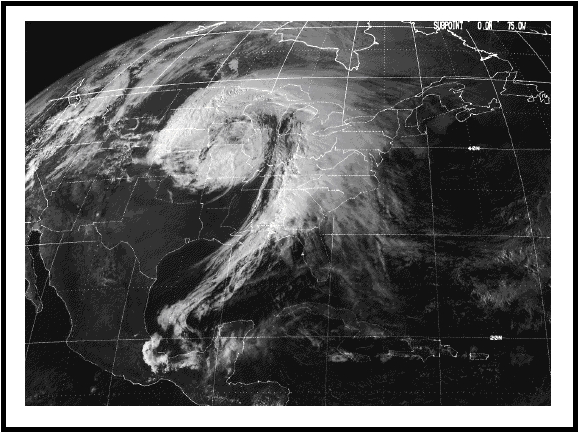
credit: Weather Channel
Why is it so hard to say what the future North European climate will look like? A recent review paper by Shaw et al, 2016 explains the reason in persuasive terms...
The weather over Northern Europe is strongly shaped by low and high barotropic pressure, associated with so-called mid-latitude cyclones. Most people refer to the most extreme cyclones as storms, although meteorologists like to use the term “synoptic storms”. The North European climate may be regarded as the weather statistics for over this region.
Shaw et al. (2016) provide a thorough assessment of the current knowledge about global warming and mid-latitude storms. They argue that there is a “tug of war” between various conditions which will affect the outcome for future mid-latitude storms as well as the jet stream. Such conditions include the south-north temperature gradient, the vertical temperature structure, ocean temperatures, and cloud cover, many of which are difficult to calculate:
The relative importance of these effects in model simulations is likely to depend on model resolution and the representation of small-scale physical processes that are not explicitly resolved by today’s global climate models.
In other words, the projection of future storm tracks is highly sensitive to aspects that are not so accurately quantified by the global climate models. This high sensitivity gives rise to a well-understood source of uncertainty connected to the way a global warming affects the mid-latitudes and the storm tracks. These effects are pronounced for the locations that already are affected by a storm tracks or where future storm tracks will end up.
The implications of this was highly relevant for a recent conference on climate change adaptation, NordicAdaptation 2016 (NA16) in Bergen, Norway. Mid-latitude storms are associated with pronounced variations in precipitation, temperature, and wind speed. The question is where, how strong, and how frequent will these storms be in a warmer world.
It was unfortunate that Shaw et al. (2016) came on-line on the first day of the conference, and was too late for adapting the presentations and the discussions. The emphasis of NA16 was on climate research to action and transformation, which implies setting up and offering a means for providing climate information (“climate services”) to decision-makers.
The challenges with storm tracks and global climate models have implications for the downscaling of regional and local consequences associated with a climate change. Hence, it is relevant for the CORDEX community because the storm track is reproduced by many global climate models, but many of them do not place them in the observed locations.
Because of these difficulties, both CORDEX and NA16 should address the gap between the climate research community and decision-makers who need to take climate information into account. There has been a view that regional climate model results will be used if they are readily accessible through a data portal such as Copernicus in Europe.
The use of climate data is probably best done through consultations with experts, a bit like medical doctors. An analogy for data portals is the drug stores, which often require a prescription from a doctor before selling a drug to avoid misuse. Medicines also come with labels. There is plenty of examples where information and data have been mishandled (see past post on learning from mistakes).
What do we say to decision-makers who are thinking about climate change adaptation?
For one, mitigation is key. There is also more information than what we can derive from climate models. This includes empirical analysis from observations, from information derived statistical theory, and a “bottom-up” approach (Pielke Sr & Wilby, 2012) that may involve a sensitivity tests to identify key variables and effects.
Hence, the outlook for mid-latitude cyclones still is unclear according to well-understood reasons explained by Shaw et al (2016), but for decision-makers, it’s a question of risk management and there is some useful information to act on. Furthermore, it is not only the direct effects that matter; One observation made during NA16 was that there will be both direct as well as indirect effects in a globalised world. A factory shut-down due to flooding in e.g. Bangkok may affect an economic chain, and persistent drought may trigger migration.
rasmus @ 6 September 2016
source: http://www.realclimate.org/
original story HERE
Get more of The Global Warming Blog. Bookmark this page and sign up for the blog’s free RSS Feed. Sign up for free Global Warming Blog by clicking here. You will automatically be emailed a regular summary of the latest global warming headlines.
To help do something about the climate change and global warming emergency, click here.
Sign up for our free Global Warming Blog by clicking here. (In your email, you will receive critical news, research, and the warning signs for the next global warming disaster.)
To share this blog post: Go to the Share button to the left below.

Be the first to comment
Sign in with